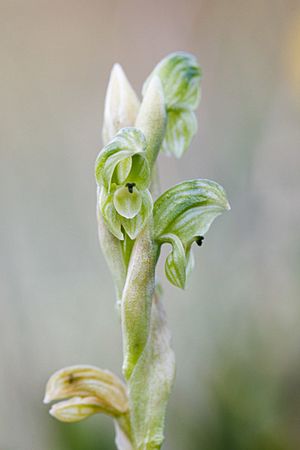Alpine swan greenhood facts for kids
Quick facts for kids Alpine swan greenhood |
|
|---|---|
 |
|
| Pterostylis crassicaulis growing in Namadgi National Park | |
| Scientific classification | |
| Genus: |
Pterostylis
|
| Species: |
crassicaulis
|
| Synonyms | |
|
Hymenochilus crassicaulis D.L.Jones & M.A.Clem. |
|
The alpine swan greenhood (scientific name: Pterostylis crassicaulis) is a special type of orchid plant. You can only find it growing in south-eastern Australia. This plant has a bunch of leaves shaped like a circle at its base, and its flowers are a mix of bluish-green and white with dark green stripes. They can have up to 18 flowers! Each flower has a unique lip-like part called a labellum that looks a bit like a dark green bird's beak. It's similar to another orchid, P. cycnocephala, but the alpine swan greenhood is usually stronger and grows in higher, colder places.
Contents
What Does the Alpine Swan Greenhood Look Like?
The alpine swan greenhood, or Pterostylis crassicaulis, is a plant that grows from an underground tuber (like a small potato). It's a perennial plant, meaning it lives for more than two years, and it's also deciduous, so its leaves die back in some seasons.
- Leaves: At the bottom of the flower stem, there's a group of 5 to 8 dark green leaves. They are packed closely together in a circle, like a rosette. Each leaf is about 20 to 45 millimeters (0.8 to 1.8 inches) long and 10 to 25 millimeters (0.4 to 1 inch) wide.
- Flowers: The plant produces between 5 and 18 shiny flowers. They are bluish-green and white with dark green lines. Each flower is about 9 to 11 millimeters (0.35 to 0.43 inches) long. These flowers grow on a stem that can be up to 300 millimeters (12 inches) tall. There are also 4 to 6 stem leaves that loosely wrap around this flowering stem.
- Flower Parts:
- The top part of the flower, called the dorsal sepal, and the petals join together to form a hood. This hood, also known as a "galea," covers the central part of the flower called the column. The dorsal sepal curves forward with its sides pointing down.
- The lower side parts, called the lateral sepals, point downwards. They are about 6 to 8 millimeters (0.24 to 0.31 inches) long and wide, shaped like a dish, and connected near their bases.
- The labellum is a special lip-like part of the orchid. It's shaped like an oblong or an egg, about 2 to 3 millimeters (0.08 to 0.12 inches) long and wide. It's pale green with a dark green, beak-like part that points forward from its base.
- Flowering Time: You can see these unique flowers blooming from December to January.
How the Alpine Swan Greenhood Got Its Name
Taxonomy
The alpine swan greenhood was first officially described in 2008 by two botanists, David Jones and Mark Clements. They initially named it Hymenochilus crassicaulis. This description was published in a magazine called The Orchadian, based on a plant found in the Kosciuszko National Park.
Later, in 2010, another botanist named Gary Backhouse changed its name to Pterostylis crassicaulis. He published this change in a journal called The Victorian Naturalist.
Naming
The second part of the scientific name, crassicaulis (which is the specific epithet), comes from two Latin words:
- crassus means "thick," "fat," or "stout."
- caulis means "stalk" or "stem."
So, the name crassicaulis basically means "thick-stemmed," referring to a feature of the plant.
Where the Alpine Swan Greenhood Lives
The alpine swan greenhood grows in high-altitude areas, specifically in alpine and subalpine grasslands and herbfields. You can find it in eastern Victoria and on the Southern Tablelands of New South Wales.

